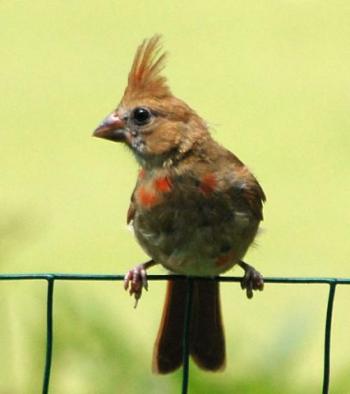Young Birds Go to “Song School”

Juvenile Northern Cardinal
Photo credit: Jim Williams
by Val Cunningham
Contributing Writer
Time spent practicing pays off next year, when the best singers get the best territories and mates.
Heading into summer there’s a change in the mellifluous robin song of early spring. That easily recognized, smooth rendition of “cheerily, cheer-up, cheerio” has been replaced by something that sounds a bit more like a series of abruptly snapped off shrieks.
Bluebirds, too, sound different, more hesitant and a bit raspy. The towhees are singing out only a portion of their “drink your TEA” song — more like “drink your” — and chickadee sounds are clipped and nasal.
Why the change? Do the males only make sweet music while they’re setting up housekeeping with a female, then afterwards don’t put much heart into it? Turns out that the current singers are different birds than the ones that warbled during April and May.
Those springtime soloists were adult males, experts at vocalizing their species’s sounds. But the birds we hear most frequently in mid-summer are their sons, hatched just weeks ago and now in a hurry to learn to sound like an adult. They require a lot of practice, because their song is not instinctual. Because it’s not hard-wired into their brain, it must be learned.
Take the robins: youngsters hatch with an idea of their species’s repertoire, based on hearing their father sing. After leaving the nest, they practice all day long, comparing the sounds coming out of their beaks to their mental template of how a robin should sound. They keep it up until there’s a good match. Then the young robin, unlike nearly all other songbirds, does something extraordinary: he creates a song that’s uniquely his own, combining robin sounds in an individual way.
Other young birds, such as bluebirds, cardinals and chickadees, run through their practice endlessly, until they can duplicate their father’s song perfectly. And just like the kid down the block who’s learning to play the violin, listening to this can be painful.
Singing like dad
Songbirds are the song learners. Young males first learn to sing like their fathers, then, when setting up their own territories, they add on the “local dialect,” so they sound like their neighbors. Young birds start out babbling just as human babies do, soon after they leave the nest. At first they’re almost inaudible as they “whisper” their practice sounds. These become louder as the young birds become more proficient.
If you listen, late in the summer, you can hear young cardinal and oriole males engaging in song practice. These youngsters vocal learning sessions are a bit easier on the ear, not so much sung as whistled.
Summer’s endless practicing pays off the next spring, when a young bird sits on his territory for the first time. His ability to croon his species’s “This is mine, keep away!” song will help him hold a territory and attract a mate.
By the time they migrate out of the state in the fall, youngsters will have their songs stored accurately in their memories. Even if they don’t sing much or at all on their winter grounds, they’ll be ready to burst forth in recognizable song when they return next spring.
Attracting a mate and holding a territory are the two most important things a songbird does in its life. Since song is the key to success in both these fields, it’s no wonder that young birds spend so much time getting it right.
St. Paul, Minnesota resident Val Cunningham, leads bird hikes for the St. Paul Audubon Society and writes about nature for local, regional and national newspapers and magazines.



